We made great internal and external advances during the year, delivering on our promise to power the renewable future. The inauguration of the Femstenaberg wind farm, which we will develop into our first hybrid park in 2025, is a perfect example.
Combining wind power with solar energy and energy storage enables a more even electricity generation that is better able to deliver renewable energy every day, all year-round, regardless of the weather.
The year involved a major investment in our internal sustainability efforts. With the aim of discerning the right initiatives and prioritizing them, we carried out our first double materiality analysis and our first climate report – important tools for measuring, following up and driving change.
During the year, we also launched our new sustainability strategy, created in collaboration with our employees. Involving so many people in the process is a strength we can be proud of.
A clear strategy and a greater understanding of the impact we have on people and the environment enable us to ramp up our sustainability efforts with the ambition of reducing our emissions and strengthening our positive impact on people and the environment.
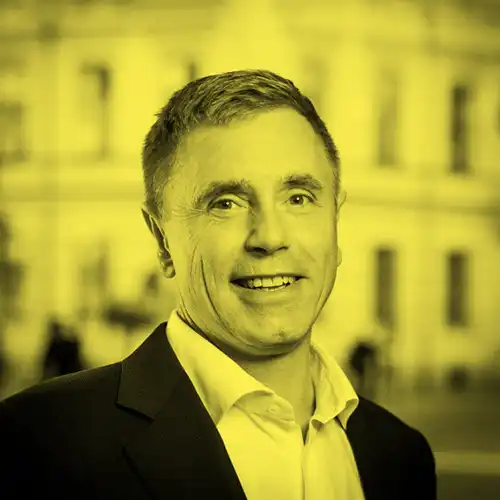
Peter Wesslau
CEO, Rabbalshede Kraft
Double materiality analysis
6 Key Areas
Our value chains
A life cycle overview of our different energy types, from raw materials extraction to dismantling.
2024
Launching our Sustainability Strategy
We kick-started 2024 with the internal launch of our sustainability strategy, jointly developed during the previous year. Implementing the strategy also meant the start of nine different subprojects.
Inauguration of the Femstenaberg wind farm
We opened our first hybrid park, and in 2025 we will add energy storage and solar power to the park.
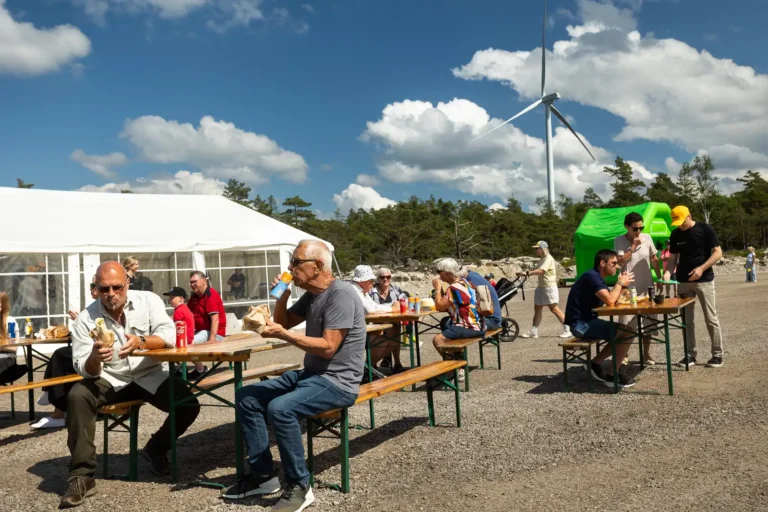
Completion of a double materiality analysis
We worked according to CSRD, the new directive for sustainability reporting, and identified our six most significant sustainability areas and a number of sub areas. These align well with the four focus areas in our sustainability strategy.
Strengthening the team
We recruited a sustainability specialist, who will continue to advance our sustainability work.
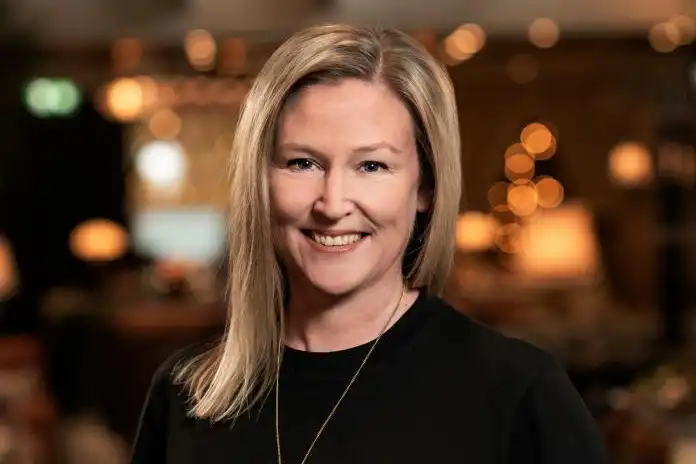
Establishing a Code of Conduct
We developed a Code of Conduct to clarify the expectations we have of all who represent Rabbalshede Kraft. It also aims to impose more stringent future standards on providers in our value chain.
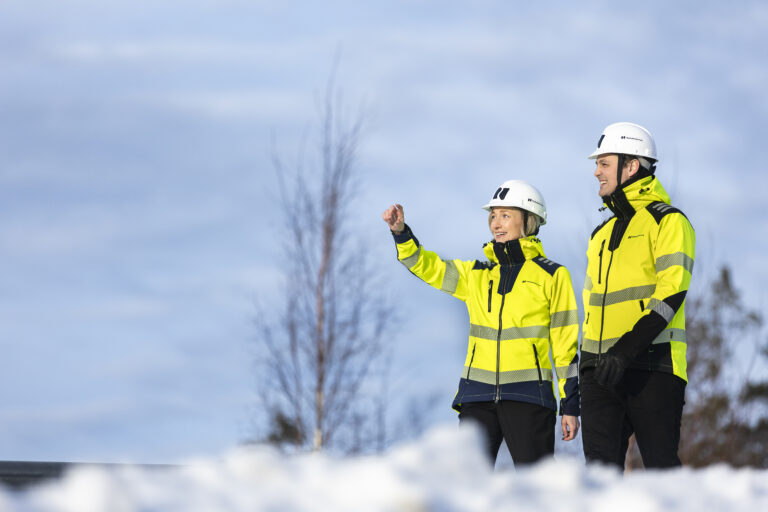
Presenting our climate report
We measure our climate impact throughout our value chain in Scopes 1, 2 and 3. The result is a climate report that provides data to help us set concrete goals for reducing our climate impact.
Method
Charting Our Operations
We set a common direction for our sustainability efforts by applying a clear strategy through strong governance. We not only seek to take responsibility for our entire operation, but also to inspire the entire industry and drive it forward.
Strategy & Governance
In 2023, we began developing a long-term sustainability strategy aimed at creating a clear focus for our sustainability work. The strategy, which was launched internally in 2024, is based on extensive collaboration across the organization.
Our sustainability strategy seeks to reflect the demands of both our operation and the outside world. Thus the process involved gathering valuable insights from employees, suppliers and partners, analyzing global trends and conducting a thorough analysis of our own strengths and challenges.
Employees from all parts of the organization were involved and by using workshops, interviews and joint discussions, we now have a sustainability strategy that is well rooted throughout our operation. It provides us with a clear action plan as to how we should develop and drive our business forward, while also protecting people, the climate and the environment.
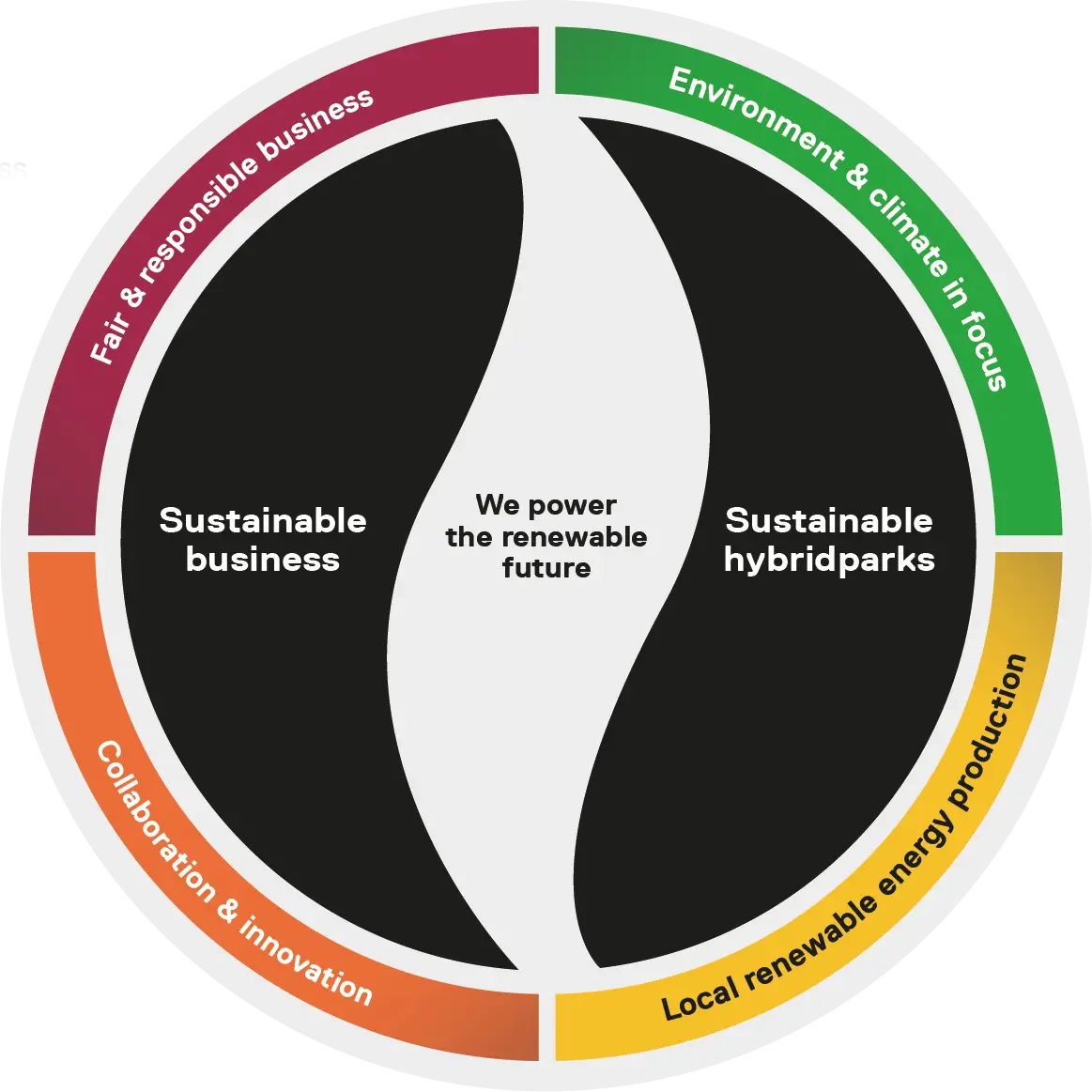
On the basis of this strategy, we also decided on concrete measures linked to the reporting of our sustainability performance. Although we are not covered by the EU Corporate Sustainability Reporting Directive (CSRD), we have drawn great benefit from using several methods that relate to the directive’s standard, ESRS. We have charted our value chain, performed a double materiality analysis and presented our first climate report.
Sustainability strategy
“Now the Real Work Begins”
Sustainability forms a natural part of Rabbalshede Kraft’s business model. We regard the transition to renewable energy as one of the solutions to the global climate crisis. Sustainability is not only part of our work, it also informs our entire operation and our values. We must raise our sustainability performance to succeed in driving the industry forward. But before we can improve something, we must first understand it, and it is here our journey began.
READ THE ARTICLE
In developing our sustainability strategy in 2024, we could have set a pretty low bar. We are a relatively small player in the energy industry and many of the demands the EU imposes on the giants do not apply to us … yet. While reviewing an operation’s sustainability is voluntary, it still involves a responsibility – one that we gladly take.
Our promise ‘power the renewable future’ is at the heart of our sustainability strategy. It’s what we’re striving to achieve. But what does this involve?
Our focus is on increasing the production of locally generated, renewable electricity and doing so sustainably in order to transition from the generation of sustainable energy to sustainable energy generation. We therefore resolved to find out what our main areas of influence are. The whole company took part in the work; we took our lead from industry associations and learned how others do things. This allowed us to identify four focus areas, which were split into two main fields – a sustainable company operating sustainable energy parks.
We need more sustainable electricity generation in Sweden to meet the demands of businesses and individuals, and our work is taking us in this direction. Just as our business is based on collaboration with local operators, sustainability performance also depends on collaboration. We must all work together to create a brighter future.
“Developing a long-term strategy that can be applied to all business areas was important. The strategy serves as a tool that guides our development in the right direction, regardless of tomorrow’s technology or type of energy. But a strategy is not the sole solution to our company’s sustainability issues. On the contrary. Now the real work begins,” declares Ida Alfredsson, sustainability strategist at Rabbalshede Kraft.
In 2024, we worked on our most important identified focus areas in nine subprojects in order to turn our strategy into practical action and make sustainability a natural part of all our procedures and decision-making processes. Each subproject involved different skills and was led by a steering group. We incorporated the strategy in our day-to-day work by splitting it into parts, thereby making it part of reality. And this was no mean feat. On the contrary, changing procedures and ensuring step-by-step improvements in e.g. our carbon footprint, is a huge undertaking.
“Rabbalshede Kraft’s clear sustainability profile gives everyone who works here a visceral sense of pride.”
Katharina Strömseng
Head of HR, Sustainability and Communication
We have also begun working with CSRD reporting according to EU regulations. Under this framework, we carried out a number of different steps, starting with a double materiality analysis. We are also presenting our first climate report in 2024, which will provide us with concrete data for use in reducing our carbon footprint.
Many parts of what was to become our sustainability strategy were already in place, but the information was scattered throughout the company. But now that analyses and data are linked, we can discern patterns and draw conclusions. Now we’re aware of our own work, both what is good and where there is room for improvement.
“The entire company worked together to find ways to improve our operation and our hybrid parks. And its creation by our own employees is what gives this strategy that little extra something. Everyone was able to have their say. It’s something we own and develop together,” says Katharina Strömseng, Head of HR, Sustainability and Communication at Rabbalshede Kraft.
Even though our product is fundamentally ‘green’, our parks have a big impact – from mining and mineral extraction upstream, to the on-site impact of parks: land use, ecosystems, biodiversity and local residents. We naturally want to minimize our negative impact as far as possible.
“Rabbalshede Kraft’s clear sustainability profile gives everyone who works here a visceral sense of pride. But there is also a profitability aspect to sustainability. Because we continue to own our hybrid parks after commissioning, we are committed to creating high-quality solutions that last throughout the hybrid park’s lifespan. We’re shaping the future, every day,” says Katharina Strömseng.
Want to read more? Click here for our full sustainability strategy.
Ecosystem
Our Place in the Outside World
As part of a greater context, we are affected by the outside world. Charting our value chain and strengthening our partnerships will help us reduce our negative impact and contribute with renewable energy.
Our Stakeholders
Maintaining dialogs with our stakeholders forms an important part of our sustainability efforts. Not only by talking about our business, but also by continuously improving our ability to innovate, collaborate and reduce emissions in our value chains.
The table shows which stakeholders are important to us and how we maintain dialogs with them.
Dialogs
Prioritized areas
Landowners
Embedding and ongoing dialogs.
Communication in early stages, farmland leases, communication for neighborhood cooperation, communication throughout the life of the park.
Authorities
Embedding and ongoing dialogs.
Permitting process, compliance with regulations from the perspectives of various authorities (international, national and local).
Community, residents, associations
Through land owners, statutory consultation and the Power of Progress – a concept aimed at giving back to the local community.
Helping to create an attractive municipality to live and work in. Ensuring transparency, long-term thinking and responsibility in projects.
Politicians and municipal officials
Embedding and ongoing dialogs, consultation process.
Municipal veto, helping to create an attractive municipality to live and work in, collaboration with local businesses, consideration for the wishes and well-being of the municipality’s residents.
Suppliers and collaborative partners
Frequent communication before, during and after projects.
Being an attractive partner who is easy to work with and supply.
Financiers and owners
Ongoing dialogs.
Profitability and sustainable development in terms of the environment, climate, society and the economy.
Employees
Performance reviews, pay reviews, the intranet, temperature checks.
Occupational safety and health, attractive employer, skills development; diversity, inclusion and equity.
Our Value Chain
There are long value chains involved in solar and wind energy, energy storage and hydrogen production, from raw material extraction and material processing to production, installation, maintenance and dismantling.
Each stage presents different sustainability challenges, such as working conditions, circularity, the handling of hazardous substances and waste management.
As a small operator, we lack direct contact with the early stages in value chains. Nevertheless, we must endeavor to reduce negative impact at every stage to help produce renewable energy that is sustainably generated.
Each stage of the hybrid park value chain in wind, solar, green hydrogen and energy storage is described here. The aim is to provide an overall picture of how value is created, the challenges involved and how Rabbalshede Kraft can help the transition to renewable energy by responsibly charting opportunities and risks.
Upstream
Raw Materials Extraction
Processing and Production
Processing minerals and refining them are energy-intensive operations that entail varying degrees of emissions. The challenges in this stage involve environmental risks, climate impact and working conditions. We can exert an indirect influence in this regard by conducting thorough supplier evaluations using criteria such as climate impact, decarbonization, supply-chain transparency and the handling and avoidance of hazardous substances. In the case of major components, climate impact is measured and evaluated throughout the life cycle.
Manufacturing
The manufacture of components for energy production involves a risk of negative impact on the environment and working conditions. We use our procurement and purchasing processes to reduce negative impact in areas such as our carbon footprint, working conditions and handling hazardous substances. We see a potential for positive influence through risk assessments, supplier collaboration and industry-specific initiatives.
Own Operations
Construction and Installation
We set the highest standards when installing in our hybrid parks in order to minimize safety and health risks. Also, the permitting process makes sure we give the highest consideration to the environment, local residents and businesses. Furthermore, procurement standards are imposed in close collaboration with the installation supplier, who in turn maintains high safety and health standards to ensure employee safety.
Maintenance and Repairs
During the operational phase in our hybrid parks, we work proactively to prevent or reduce any negative impact on biodiversity and ecosystems in accordance with the hierarchy of considerations. We take protected species into consideration and manage invasive species. We measure ‘pollution’ such as sound, light and shade, and stress the importance of chemical management. We require service contractors and suppliers to make sure people who work in our parks comply with the safety regulations in our Operating and Maintenance Manual and the occupational safety and health plan, in accordance with Swedish legislation and industry standards.
Downstream
Dismantling, Reuse, Recycling and Disposal
We own our parks throughout their lifetimes, and this allows us to avoid and reduce waste by working over the long-term based on the principles of the waste hierarchy. Our work includes extending the lifetime of our installations in order to reduce the extraction of virgin materials. We follow developments in the circularity of wind turbine blades and we collaborate on innovations in product development and product reuse. We recycle materials and manage waste according to Swedish legislation, and we measure our carbon footprint continuously throughout our operations.
Throughout the Value Chain
Transport
Transport takes place throughout the value chain and contributes to different emissions depending on the type of transport and fuel. With the exception of one diesel-powered service vehicle, we operate electric vehicles to limit in-house climate impact. Transport that takes place upstream is presented in our climate report under the line item for purchased goods and services.
Our Value
Energy production is the final stage in our value chain. By adding a greater proportion of locally produced renewable energy, we see great potential for helping to reduce climate impact in the value chains of other players.
In 2024, our parks produced
GWh of renewable energy
Footprint
Impact, Risks, and Opportunities
An important part of our sustainability efforts involved identifying impact, risks and opportunities in our value chains. The double materiality analysis helped us prioritize the most important sustainability issues in our operation.
Key Sustainability Issues
The double materiality analysis has identified six key areas:
These areas relate well to our own sustainability strategy and will be prioritized in our continued sustainability work.
Climate Change
Impact, risks and opportunities
Consequential materiality: The company’s production of renewable electricity contributes to a lower climate impact from the energy sector by replacing fossil energy sources. However, the manufacture and installation of wind turbines and solar panels results in significant greenhouse gas emissions (CO₂e) in the value chain, which constitutes a negative climate impact. It is this balance between positive and negative impacts that makes climate change a key area.
Financial materiality: Expanded renewable capacity can contribute to variable electricity prices, which entails both risks and opportunities. High electricity prices can present a financial opportunity, while lower prices during high production represent a financial threat.
How we address the issues
The first climate report for Scopes 1, 2 and 3 was presented in 2024. It provides the ability to set relevant emissions reduction targets by highlighting our direct and indirect emissions. We also use our procurement process to reduce fossil fuels in our value chains. Hybrid technology and energy storage counteract financial risks.
Pollution
Impact, risks and opportunities
Pollution to air, water and soil is considered to be significant upstream in the value chain. There are 19 materials in the operation that have a major environmental impact according to SBTN’s High Impact Commodity list (HIC), including steel, iron, cement, crude oil, aluminum and copper. Emissions of sulfur dioxide, oxides of nitrogen, polyaromatic hydrocarbons and harmful volatile organic compounds occur in the value chain.
How we address the issues
We analyze business intelligence and evaluate subcontractors on an ongoing basis. We use the procurement process to demand transparency and traceability in the value chain, the exclusion of harmful substances and compliance with UN Global Compact principles.
Biodiversity and Ecosystems
Impact, risks and opportunities
The survey shows an estimated medium impact upstream and in our own operations via extraction, production and construction. There is also a moderate risk of our contributing to deforestation.
How we address the issues
We seek to mitigate negative impact by analyzing business intelligence, working jointly in industry forums and evaluating suppliers with a focus on transparency in the value chain. Work is in progress in our own operations to avoid, limit, restore and compensate for our impact on biodiversity and ecosystems under the hierarchy of considerations.
Circular Economy
Impact, risks and opportunities
The production of wind turbines and major components that form the basis of the operation requires large quantities of virgin resources. Currently, the proportion of circular material used is low.
How we address the issues
We follow circularity research in the industry, including how to recycle existing wind turbine blades in due course, and how to achieve a transition to blades with a higher recycling rate. We have also begun a pilot project on how to avoid and minimize waste, increase material recycling and the proportion of recycled materials in our components, all under the waste hierarchy. We are also working with life-cycle extension and collaborations for the reuse of components that have to be replaced.
Our Own Workforce
Impact, risks and opportunities
The operation involves a certain risk of work-related accidents and illnesses, both physical and mental, when working at heights.
How we address the issues
We constantly apply preventive measures through procedures and processes (e.g. the occupational safety and health policy, Code of Conduct, operation & maintenance manual). For preventive purposes, we also use training, employee performance reviews, thorough and extensive wellness programs and temperature checks via Winningtemp that show employee engagement and well-being.
Employees in the Value Chain
Impact, risks and opportunities
Potentially, there are major work-related risks at multiple levels upstream in the value chain in places where our visibility is limited. Rare earth metals, other metals and minerals are often mined in countries where there are often reports of poor working conditions and inferior rights for workers.
How we address the issues
In our procurement processes, we conduct extensive supplier evaluations based on our Code of Conduct. We demand transparency and compliance with the principles of labor legislation as set forth in the UN Global Compact.
Power nugget 01
50 km
Is how far one spin of a wind turbine will take you in an electric car.
Source: Energimyndigheten och Trafikverket
Double Materiality Analysis
We operate in a complex, changing energy industry in which solar, wind, hydrogen and battery solutions work together. Because it is essential that we know which sustainability issues are most relevant in order for us to create long-term value and take responsibility, we conducted a double materiality analysis.
The work was carried out during the spring of 2024 and the process included workshops, interviews and ongoing cross-checks with our external consultants at 2050.
Inside-out perspective – Consequential materiality considers how our operation impacts the environment, people and society.
Outside-in perspective – Financial materiality considers how sustainability aspects can impact our business model, governance, market position and profitability.
The double materiality analysis was carried out according to the EU Sustainability Reporting Standard (ESRS). Thus the assessment covered both consequential materiality (Rabbalshede Kraft’s impact on sustainability issues) and financial materiality (the impact of sustainability issues on Rabbalshede Kraft’s financial position and earnings).
The entire value chain was analyzed, both upstream and downstream. Having involved various stakeholders and analyzing both internal data and external trends, we feel confident that our assessments are well-founded and relevant.
All topics covered by ESRS have undergone a thorough assessment to make sure all relevant sustainability aspects have been considered: Climate Change, Pollution, Water and MarineResources; Biodiversity and Ecosystems; Circular Economy; Our Own Workforce, Employees in the Value Chain, Affected Communities, Consumers and End-Users, and Corporate Social Responsibility.
The results of our double materiality analysis with our six key topics are presented below. We describe how the most critical sustainability issues for Rabbalshede Kraft were identified and evaluated.
Since there is relatively high uncertainty about such things as actual conditions in the supply chain, which also includes raw material extraction, we will in future work to enhance our insights and knowledge of how sustainability impacts are handled in the value chain.
*Data lacking
power nugget 02
Microplastic Emissions
Source: Naturvårdsverket, IVL
Climate Report
As part of the follow-up process for the double materiality analysis, and to enable us to take measures to reduce emissions, we presented a climate report for 2024 in accordance with the Green House Gas Protocol (GHG).
We have sorted our greenhouse gas emissions under Scopes 1–3. Our total emissions in 2024 were 34,402 metric tons of CO₂e. By far the largest share, 94%, is in Scope 3, indirect emissions in the value chain.
Scope 3 accounts for 94% of our total emissions, of which 94% are from the construction phase. This is largely because all emissions from Femstenaberg-Lursäng windfarm construction were reported in 2024, when the park was commissioned. The actual wind turbines are the largest single emission factor in the construction phase.
But the forecast for 2025 is that emissions in the operation and maintenance phase will be the most significant, as no park is scheduled for commissioning during that year.
Emissions 2024
Metric tons CO₂e
Scope 1 – Direct emissions from operations
Energy parks
1,183
Other operations
1
Total
1,184
Scope 2 – Emissions from the production of electricity, district heating and cooling
Electricity generation
1,014
Other electricity and district heating
2
Total
1,016
Scope 3 – Purchased goods and services
Purchased goods and services
398
Capital goods
30,955
Energy and fuel-related emissions
103
Upstream transport
–
Waste
0.2
Business travel
41
Commuting
10
Investments
695
Total
32,202
Scope 1–3 total
34,402
power nugget 03
1 ton CO₂e
=
5,000 km by car, or round trip Gothenburg–Madrid by air
Source: Naturvårdsverket, Trafikverket och Internationella flygbranschens emissionsdata
Case
The Hybrid Park
We believe in a diversified system in which we use multiple types of energy to deliver renewables all year round. Because we own our parks, we can develop them over long-term with hybrid technology. We are currently building our first hybrid park in Femstenaberg.
A Place for Energy
Rabbalshede Kraft owns and operates the Femstenaberg hybrid park. The project was initiated back in 2008, largely thanks to the great interest from local landowners.
Today, the park combines several different energy technologies. Wind turbines came first. Next came battery storage, and solar power will be added moving forward. Because the hybrid park is located in southern Sweden, it makes an important renewable electricity contribution in price area 3, which currently has a deficit in electricity generation.
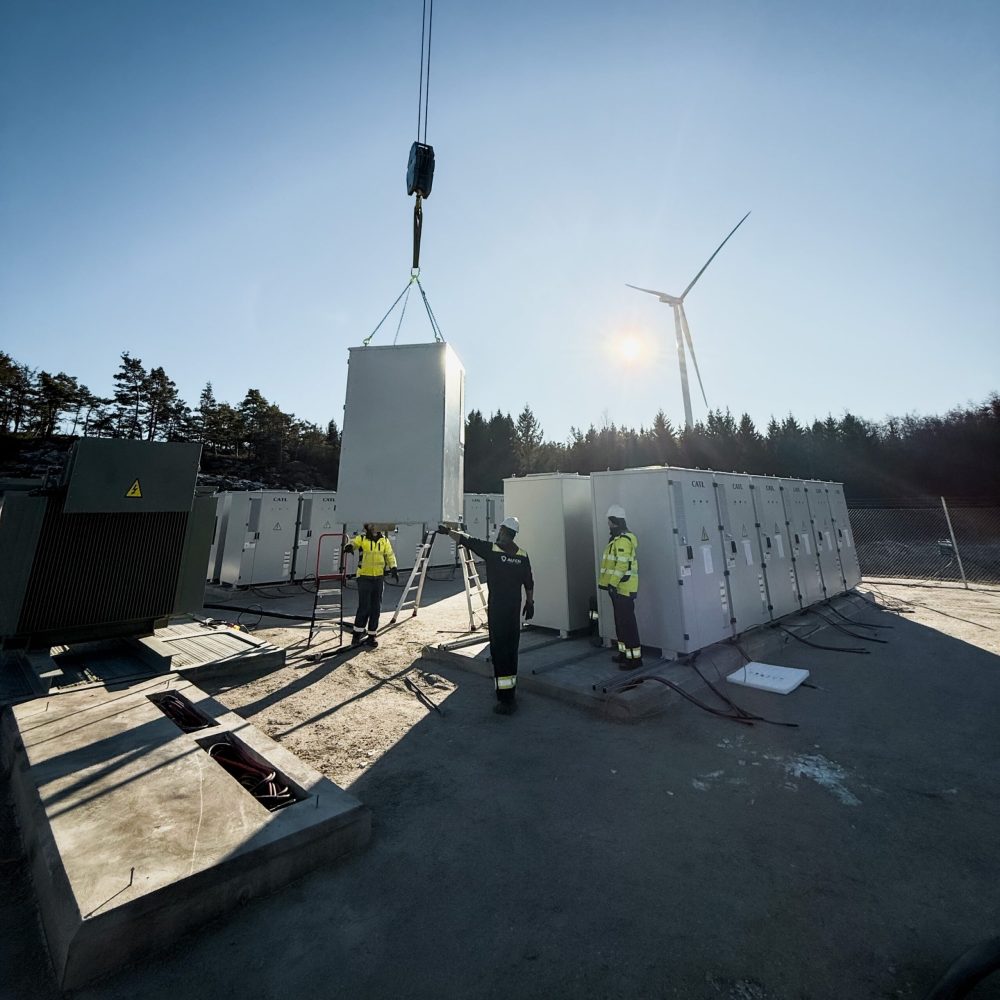
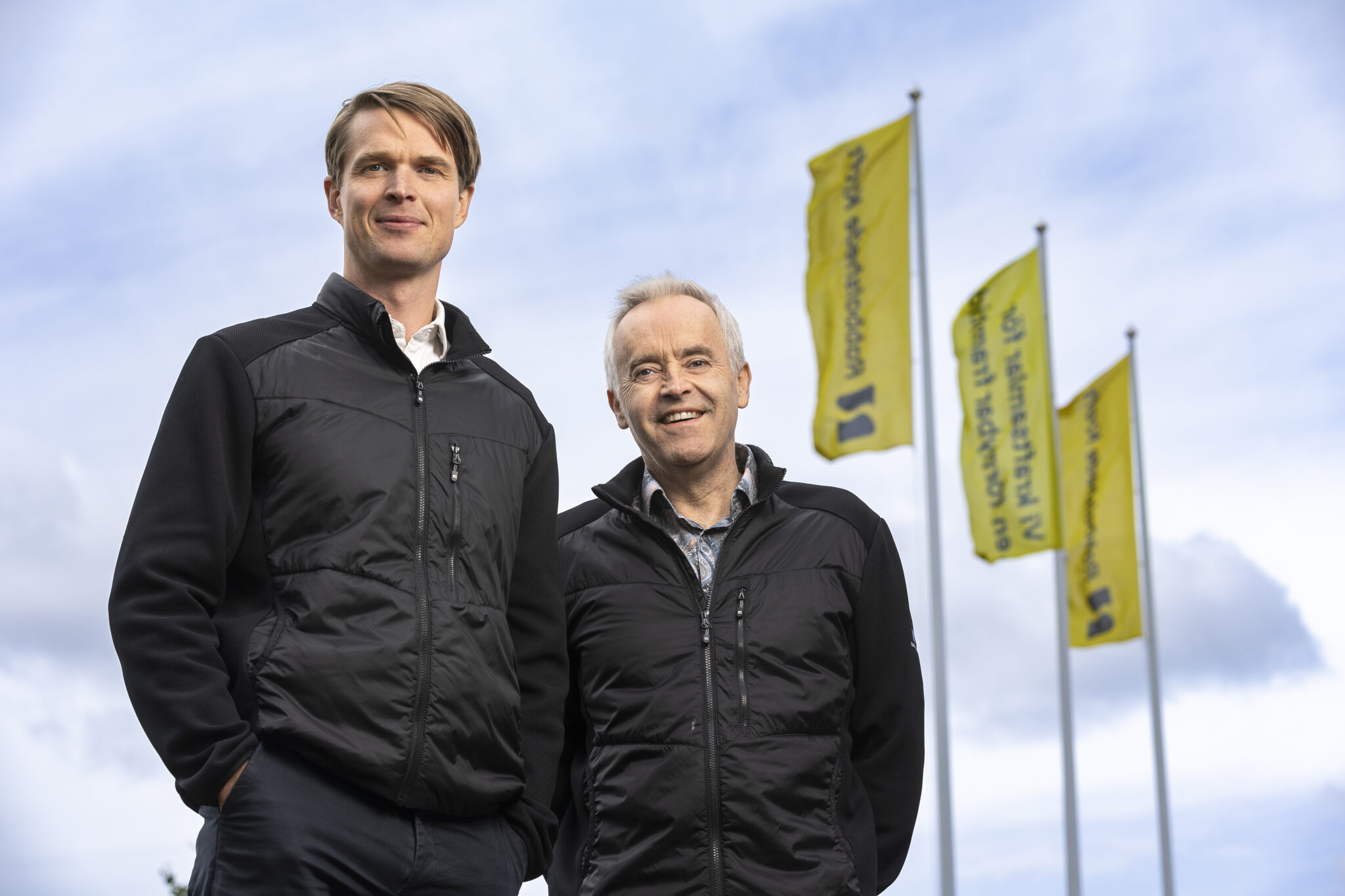
Hans Svensson, Project Manager for Construction.
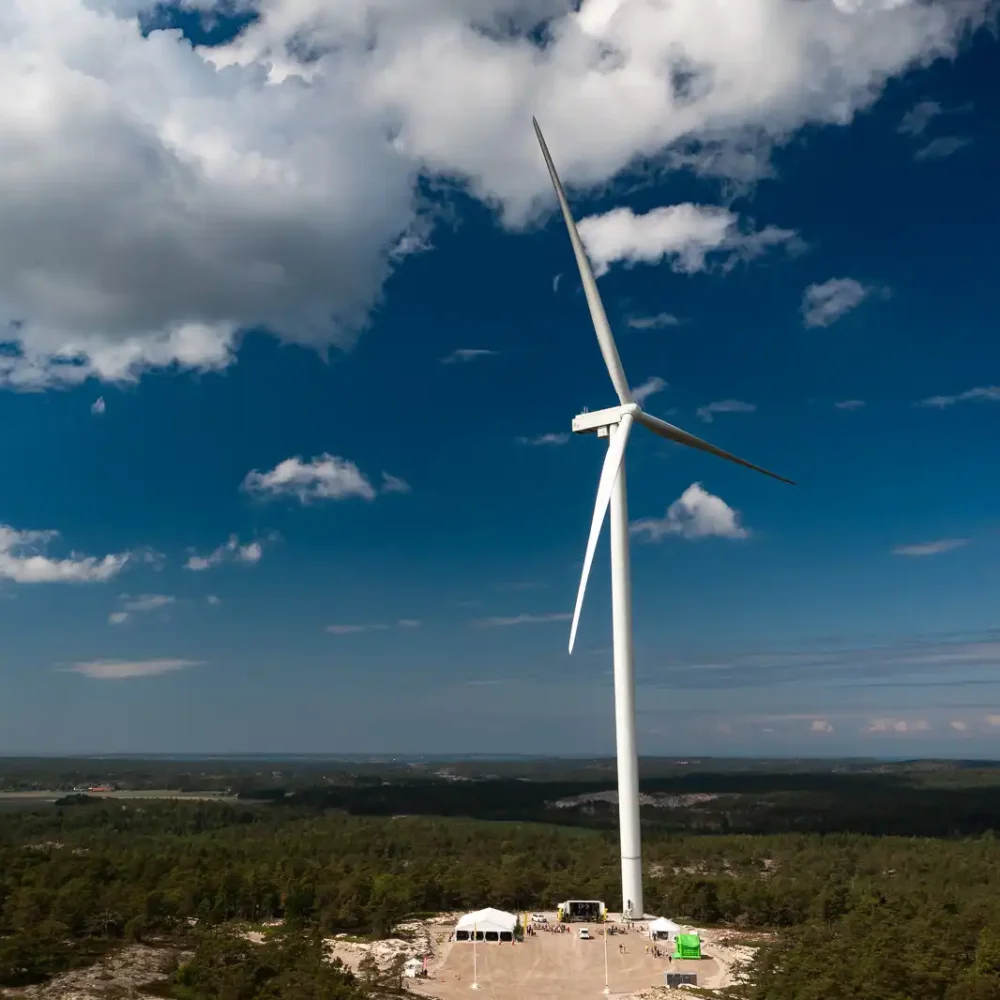
Renewable Energy in All Weathers
We are building our first hybrid park in Femstenaberg outside Strömstad. It began as a wind farm, but because we continue to own our parks after commissioning, we can add technologies to existing parks.
READ THE ARTICLE
In recent years, large-scale batteries and solar power have both become commercially viable on the Swedish market. We are therefore building battery storage in Femstenaberg and will also add a solar installation to enable us to produce and store even more renewable electricity in a single location. These days we always seek permits to build hybrid parks for the co-location of multiple technologies.
“Building hybrid parks allows us to use land and resources more effectively and sustainably, from several perspectives. We don’t need to build new roads or use entirely new locations; we only use land that is already approved for one energy technology in order to get more out of the area. What’s more, it also requires only one grid connection, which is good, as additional connections are both expensive and time consuming to install,” says Tobias Nylander, Development and Construction Manager at Rabbalshede Kraft.
The biggest advantage of using multiple technologies in a single park is in their enabling the more efficient use of prevailing weather conditions. Wind tends to be weaker in sunny weather, while the darker months are often all the windier. With the aid of battery storage or green hydrogen installations, i.e. hydrogen produced entirely from renewable sources, we can balance over-production and store any electricity that is not needed immediately. This enables the provision of renewable electricity even during periods of high demand, thereby reducing the need for fossil energy sources.
“This is what tomorrow’s renewable hybrid park looks like.”
Tobias Nylander
Head of Development and Construction
“Society needs baseload power that is always available, affordable and sustainable in terms of the environment. Renewable energy will always be weather dependent; we cannot control how the wind blows or the sun shines. But by putting everything behind the same meter and using batteries or hydrogen as backup, we can achieve stable, predictable electricity production. “This is what tomorrow’s renewable hybrid park looks like,” says Tobias Nylander.
During construction, we had to raise the ground three meters to adapt the battery installation to the existing grid station built for the wind farm, as conventional rock material could not be used owing to geo-technical challenges. We used foam glass instead, made from recycled glass mixed with air. It resembles small, gray, slightly uneven rocks, and although it is significantly lighter it has the same load-bearing capacity as crushed rock.
“Foam glass is a fantastic material to work with, partly because it’s 100 percent recycled, but mainly because it’s so quick and easy to use. We were able to fill 5,000 cubic meters with foam glass in five days, which would have taken three weeks with rocks,” says Hans Svensson, Project Manager for Construction at Rabbalshede Kraft.
Collaboration with the municipality went very smoothly, and the owner of the land where the battery is located was particularly involved in the energy park.
“The landowner was a great asset for us. He lives right next to the area and was always on hand. We hired him whenever we needed extra help; he shoveled snow when needed and was very involved in the construction. Now that the park is finished, we hire him to take care of ground service. He’s a huge benefit for us,” says Hans Svensson.
“Because we know we will continue to own the hybrid parks we build after commissioning, we’re committed to the highest quality construction, creating good relationships with everyone involved and taking good care of the area. We’re here to stay,” says Tobias Nylander.

Hans Svensson, Project Manager for Construction.
Femstenaberg in Numbers
Output (MW)
Prod./year (GWh)
Other information
Wind farm
7 turbines, height 200 m.
Solar park
Construction start 2027
Battery
–
Operational spring 2025
Total
Incl. contributions from neighboring farm
power nugget 04
GHG emissions by energy type
Gram CO₂e/kWh
Source: IPCC AR6 WGIII (2022)
Our Work Continues
In 2024, we teamed up to survey the impact of our operation in extensive analyses.
In 2025, using our strategy as a basis and with insights from work already completed, we will set measurable goals linked to our key areas and our sustainability strategy.
During the year, we will develop a clear, concrete roadmap and activate it in our pilot projects for reducing climate impact, and increasing circularity, sustainable procurement and ecological sustainability in our parks.
With new insights from our climate report, stakeholder dialogs, the double materiality analysis and a well-embedded strategy, we see every possibility to continue pursuing proactive, long-term sustainability work.
